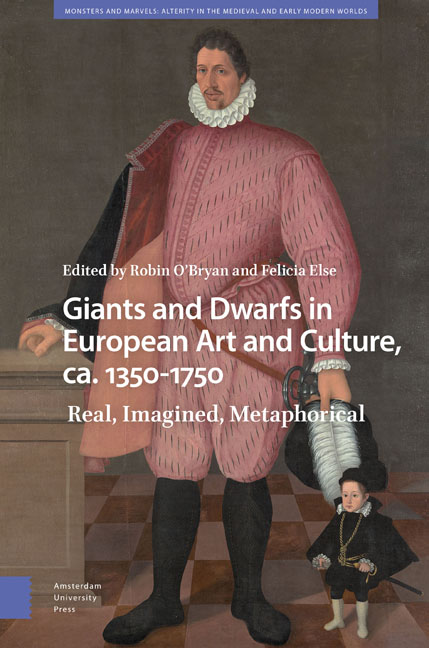Introduction : Giants and Dwarfs as Real, Imagined, and Metaphorical Entities
Published online by Cambridge University Press: 13 April 2024
Summary
Abstract
This introductory chapter provides a broad survey of the ways in which the enthusiasm for giants and dwarfs pervaded European art and culture in the late medieval and early modern eras. As well as examining dwarfs and the occasional giant who served in the courts, the discussion extends to giants and dwarfs featuring in courtly and public festivities. From there it moves on to show how dwarfs became ubiquitous motifs in painting, sculpture, and the graphic arts, with giants portrayed literally or expressed metaphorically in colossal figures. As the investigation reveals, despite their variations in size, giants and dwarfs were frequently invested with the same symbolism and character traits, assigned magical properties, and viewed in both negative and positive ways.
Keywords: European courts, festivals, chivalric romances, monsters, apotropaia, gender
Published in 1868, Edward Wood's Giants and Dwarfs is a treasure trove of facts and legends about giants and dwarfs that range from the real to the improbable to the downright impossible. He tells us of biblical giants like the Nephilim who commingled with the daughters of men, and the mighty Goliath who was eight to twenty feet tall and killed by David. Among the mythological giants, the Cyclops Polyphemus lived in a cave and fed upon human flesh, with Antaeus of Libya meeting his match in his battle with Hercules. In Roman times the emperor Maximinus Thrax (the Thracian, r. 235–38) was said to have topped almost nine feet, his hands so large he used his wife's bracelet for a thumb-ring. Over a thousand years later it was claimed that the Dutch giant Nicholas Kieten could carry men under his arms as if they were children, and that four people could stand together in one of his massive shoes. Dwarfs, too, were described in equally fantastic terms. Conflated with the mythical pygmies of the monstrous races, they were similarly reputed to live in caves and likewise did battle with Hercules (after he defeated Antaeus with whom they had claimed an alliance). Of actual dwarf individuals, the grammarian and poet Philetas of Cos (ca. 340–ca. 270 BCE) was reputed to be so small and slender he had to keep lead in his pockets to keep from being blown away.
- Type
- Chapter
- Information
- Giants and Dwarfs in European Art and Culture, c. 1350-1750Real, Imagined, Metaphorical, pp. 19 - 66Publisher: Amsterdam University PressPrint publication year: 2024

